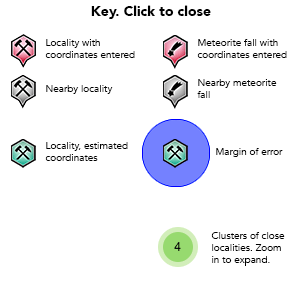Linger and Die Gold Mine, Mertondale Goldfield, Leonora Shire, Western Australia, Australia

| Latitude & Longitude (WGS84): | 28° 37' 50'' South , 121° 19' 14'' East |
|---|---|
| Latitude & Longitude (decimal): | -28.63078,121.32073 |
| GeoHash: | G#: qdym0ezj9 |
| Locality type: | Mine |
| Köppen climate type: | BWh : Hot deserts climate |
Not only is this the name of a mine, but provides helpful advice about the dangers of travelling into remote parts of the outback.
This historic mining area is half way between the large King of the Hills Mine/Goldfields Highway to the west, and Mertondale to the east, about 30 kilometres north north-east of Leonora as the crow flies. It is not near any road, and access is problematic. The easiest access is via various station tracks going east from just north of the King of the Hills Mine. It is a maze, follows probably station fences, and would need permission from the station owner.
The deposits were discovered sometime shortly after 1900. The initial alluvial dryblowers obtained 20 ounces, at least officially, although it was probably more. A syndicate was formed to open the Linger and Die Mine, which operated for a couple of years around 1905 to 1907, but the distance to a battery hampered operations, and it was abandoned. The site is now marked by two tiny open pits, from a more recent enterprise.
This mining in the 1980's produced 2007 tonnes of ore at 11.77 g/t. Historical to this point from 1897 the deposits at Linger and Die have produced 2000 ounces of gold from 1400 tonnes of ore.
The area came to life again from 1911 to 1915, as prospector shows, each lease being individually named.
One source states the Myrtle is north of Linger and Die, up Dodgers Creek. About 200 metres north of the pits, is a short line of historic shafts, which is possibly the location.
The Glenlyon name was during the tenure of Crowley and party, and thereafter it was known as the Myrtle. The mine was idle in 1913. Travers and Bradshaw worked it in 1914. Then Luhrs and Travers took over. They sank a shaft at the extreme end of the old workings. Luhrs is said to have worked at the mine in its early days then returned around 1915 to work it again.
A couple of sources state Thompson and Alexander worked the mine, but dates are not mentioned. Yet another source in 1914, states Phillips and Morris from the Bung Eye lease, had also taken up the Myrtle. This highlights the confusion and lack of accuracy relating to small remote prospector shows.
Another named lease was called Bung Eye, operated by Phillips and Morris (surnames) from 1912, then by J. Thompson in 1915. He had sunk a new shaft south of the old workings. One source states this is north of the Myrtle mine, and about 200 metres north-east is another group of historic shafts. Reggal and party are noted at the mine in 1915.
In 1907, the battery at the Great Gwalia mine was dismantled and re-erected at the Golden Champion Mine. This was a boon to local prospectors, as the cost of cartage of ore to the Leonora, or King of the Hills battery had been prohibitive to that point. The battery was removed in 1913. Ashley and Phillips had a prospecting shaft west of the Golden Champion Mine in 1915, on a reef averaging 3 feet wide.
C. Westmore operated The Ivy lease from 1910 to 1915.
The location is just east of the Keith-Kilkenny Shear Zone. The prominent fabric elements in the two small pits from 1980's mining, show extensional movements to the east. The gold is hosted in quartz veins associated with normal or extensional movements. The veins are overprinted by discrete normal faults, striking east-west. Steep localised strike slip faults subsequently developed during a localised D2 north-east to south-west contraction.
Commodity List
This is a list of exploitable or exploited mineral commodities recorded at this locality.Mineral List
3 valid minerals.
Rock Types Recorded
Select Rock List Type
Alphabetical List Tree DiagramRegional Geology
This geological map and associated information on rock units at or nearby to the coordinates given for this locality is based on relatively small scale geological maps provided by various national Geological Surveys. This does not necessarily represent the complete geology at this locality but it gives a background for the region in which it is found.
Click on geological units on the map for more information. Click here to view full-screen map on Macrostrat.org
| Statherian - Orosirian 1600 - 2050 Ma ID: 909179 | felsic intrusives 72645 Age: Paleoproterozoic (1600 - 2050 Ma) Description: Undifferentiated felsic intrusives, some gneissic Comments: igneous felsic intrusive; synthesis of multiple published descriptions Lithology: Igneous felsic intrusive Reference: Raymond, O.L., Liu, S., Gallagher, R., Zhang, W., Highet, L.M. Surface Geology of Australia 1:1 million scale dataset 2012 edition. Commonwealth of Australia (Geoscience Australia). [5] |
| Neoarchean - Mesoarchean 2500 - 3200 Ma ID: 3189870 | Archean intrusive rocks Age: Archean (2500 - 3200 Ma) Comments: Yilgarn Craton Lithology: Intrusive igneous rocks Reference: Chorlton, L.B. Generalized geology of the world: bedrock domains and major faults in GIS format: a small-scale world geology map with an extended geological attribute database. doi: 10.4095/223767. Geological Survey of Canada, Open File 5529. [154] |
Data and map coding provided by Macrostrat.org, used under Creative Commons Attribution 4.0 License



